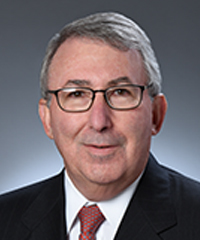Rheumatology
Rheumatoid Arthritis
Advantages of Switching to a New Mechanism of Action
Overview
In years past, when a patient with moderate to severe rheumatoid arthritis (RA) received an inadequate response to the initial biologic therapy, the path forward meant cycling to another anti–tumor necrosis factor (anti-TNF) therapy. Over the years, more options have become available, with interleukin 6 (IL-6) inhibitors and Janus kinase (JAK) inhibitors representing 2 of the more recent additions. Today, experts recognize several potential advantages of switching to a non-TNF mechanism after the first anti-TNF failure.
Q: What are the merits of switching to a different mechanism of action (MOA) in patients who have had an inadequate response to therapy?
Alan L. Epstein, MD
|
|
“For that person who has had a primary inadequate response (TNF-IR), it would make sense to consider switching to a drug with a different MOA.”
I think that there are a number of ways that we can approach this question. Let’s consider the patient who is taking methotrexate (MTX) and has had an inadequate response to an appropriate dose of MTX. Consequently, he or she is started on an anti-TNF agent, and after an appropriate period of time, let’s say 3 to 4 months, the patient’s response is inadequate. I prefer the term inadequate because almost everybody has at least some response to anti-TNF agents. For that person who has had a primary inadequate response (TNF-IR), it would make sense to consider switching to a drug with a different MOA. This is reflected in current American College of Rheumatology guidelines. The European League Against Rheumatism guidelines perhaps suggest an inadequate response to 2 anti-TNF agents, but when a person has had a primary inadequate response to an anti-TNF agent, it would seem reasonable in the scientific sense to consider a drug that works by a different MOA—whether that be IL-6 inhibition, B-cell depletion, blocking T-cell activation, or JAK/signal transducer and activator of transcription inhibition.
The other point, which I know we will be discussing in a bit more depth later, is that of biologic monotherapy. We do have some data that indicate that other drugs with other MOAs are perhaps a little bit more efficacious than an anti-TNF agent when used as monotherapy in those patients who, for whatever reason, are not taking MTX.
Leonard H. Calabrese, DO
|
|
“I think that the prescribing trends will reveal that we are being much more liberal with starting non-TNF biologics.”
I agree with that. I think that, by and large, the only time clinicians are sticking with anti-TNFs meticulously is when, primarily, there is some kind of adverse event initially, let’s say an infusion reaction or an injection site reaction, and some immunogenicity could be added to that. I think that nearly everyone moves on from primary failures to a different MOA. And I think that, increasingly, we move on after single TNF failures, since we are blessed to have so many drugs with different MOAs. I think that the prescribing trends will reveal that we are being much more liberal with starting non-TNF biologics.
Stanley B. Cohen, MD
|
|
“[In the ROC trial], those patients who moved to a different MOA actually did better, as far as low disease activity and remission.”
I agree with all of that. We have limited data, but some data, certainly with golimumab, that speak to the question of how to proceed after anti-TNF failure. And there was a study by Gottenberg and colleagues published in JAMA a couple of years back with data from a European trial, out of France, called the ROC (Rotation or Change) trial. This was a randomized clinical trial where they enrolled patients who had failed a TNF inhibitor due to lack of efficacy to investigate the “rotation of therapy” to a second anti-TNF agent, as opposed to a change in therapy to a biologic with a different MOA. So, in the clinic, the physicians were allowed to choose another TNF inhibitor or move to a biologic with a different MOA. And those patients who moved to a different MOA actually did better, as far as low disease activity and remission. A greater proportion of patients achieved an effective clinical response with a non-TNF biologic versus those who had taken a second anti-TNF drug. So, I think that, today, most of us, after anti-TNF failures, are certainly giving more thought to moving to a non-TNF biologic for those patients, in contrast to the past.
Dr Epstein:
I think that Dr Cohen is absolutely correct. Although the data are somewhat limited, in all of the studies that I am aware of in TNF-IR patients (studies that compare cycling to another anti-TNF agent with moving to a different MOA), it always seems to be the case that those who move to a different MOA come out better. I think that, following a primary inadequate response, it would be reasonable to try a different MOA. Just to complete the thought, suppose a patient had an exceptionally good response to, let’s say, an anti-TNF agent. However, after a fairly long period of time, he or she developed an inadequate response, hence a secondary loss of efficacy, and one might argue that this was due to anti-drug antibodies. Then, perhaps, the initial mechanism is still a good one for this patient. In this case, where the lack of efficacy was a secondary phenomenon, one might consider using another anti-TNF agent.
Daniel E. Furst, MD
|
|
I am in agreement with my colleagues here. There are several targets that have been very effective, and mechanisms that include TNF inhibition, but also IL-6 receptor inhibition, JAK inhibition, B-cell depletion, and T-cell costimulation blockade, just to name a few. I would add that applying genetics to individual patient care is, to me, a huge and exciting area. Yes, it has been frustrating, but I see it slowly moving forward. So, to me, once we actually can define how a patient is going to respond, that is going to be a major and important step forward.
References
Chastek B, Chen CI, Proudfoot C, Shinde S, Kuznik A, Wei W. Treatment persistence and healthcare costs among patients with rheumatoid arthritis changing biologics in the USA. Adv Ther. 2017;34(11):2422-2435.
Firestein GS. The disease formerly known as rheumatoid arthritis. Arthritis Res Ther. 2014;16(3):114.
Fleischmann R, van Adelsberg J, Lin Y, et al. Sarilumab and nonbiologic disease-modifying antirheumatic drugs in patients with active rheumatoid arthritis and inadequate response or intolerance to tumor necrosis factor inhibitors. Arthritis Rheumatol. 2017;69(2):277-290.
Gottenberg JE, Brocq O, Perdriger A, et al. Non-TNF-targeted biologic vs a second anti-TNF drug to treat rheumatoid arthritis in patients with insufficient response to a first anti-TNF drug: a randomized clinical trial. JAMA. 2016;316(11):1172-1180.
Rein P, Mueller RB. Treatment with biologicals in rheumatoid arthritis: an overview. Rheumatol Ther. 2017;4(2):247-261.
Singh JA, Saag KG, Bridges SL Jr, et al. 2015 American College of Rheumatology Guideline for the Treatment of Rheumatoid Arthritis. Arthritis Rheumatol. 2016;68(1):1-26.
Smolen JS, Landewé R, Bijlsma J, et al. EULAR recommendations for the management of rheumatoid arthritis with synthetic and biological disease-modifying antirheumatic drugs: 2016 update. Ann Rheum Dis. 2017;76(6):960-977.














